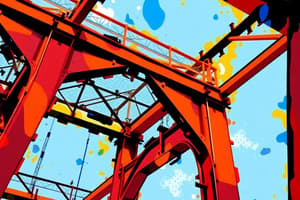Podcast
Questions and Answers
What type of steel structure is known for its lightweight construction and expansive open interiors?
What type of steel structure is known for its lightweight construction and expansive open interiors?
- Skeleton Steel Structure
- Steel Framing System
- Space Frame Structure (correct)
- Truss Structure
Which steel structure type is suitable for long-span constructions without compromising structural integrity?
Which steel structure type is suitable for long-span constructions without compromising structural integrity?
- Truss Structure (correct)
- Skeleton Steel Structure
- Steel Framing System
- Portal Frame Structure
What is a key factor that architects and engineers need to consider to ensure optimal indoor comfort levels in steel structures?
What is a key factor that architects and engineers need to consider to ensure optimal indoor comfort levels in steel structures?
- Thermal Conductivity (correct)
- Types of Steel Structures
- Design Complexity
- Initial Cost
Which steel structure type is often used in residential applications and streamlines construction by prefabricating components off-site?
Which steel structure type is often used in residential applications and streamlines construction by prefabricating components off-site?
What challenge do intricate steel structures pose during the design and engineering phases?
What challenge do intricate steel structures pose during the design and engineering phases?
Study Notes
Steel Structure Design: Key Points and Considerations
Steel structure design plays a crucial role in modern construction, offering strength, versatility, and innovative possibilities for a wide range of projects. While the design process involves various models, standards, and methods, there are several key points to consider when designing steel structures.
Design Standards
Steel structure design is subject to government-regulated standards, such as Eurocode 3, which provides rules and regulations for steel projects. These standards ensure that designs meet specific structural requirements and comply with building codes.
Types of Steel Structure Design
There are several types of steel structure design, including:
- Simple Design: Suitable for straightforward structural configurations, simple design techniques ensure optimal load distribution and stability while minimizing material usage and construction complexity.
- Continuous Design: Continuous design methods involve seamless integration of steel elements to create uninterrupted load paths, enhancing structural efficiency and resilience against external forces.
- Semi-Continuous Design: Combining aspects of both simple and continuous design principles, semi-continuous design approaches strike a balance between structural performance and construction feasibility, offering versatility and adaptability in varying architectural contexts.
Structural Forms
Steel structures come in various forms, each tailored to meet specific architectural needs:
- Portal Frame Structure: Utilized in both industrial and residential settings, portal frame structures feature rigid frames with columns and rafters, providing exceptional strength and stability.
- Truss Structure: Characterized by interconnected triangular units, truss structures distribute weight efficiently, allowing for long-span constructions without sacrificing structural integrity.
- Skeleton Steel Structure: Employing a framework of steel beams and columns, skeleton steel structures offer versatility and adaptability, accommodating diverse architectural styles and layouts.
- Space Frame Structure: Known for their lightweight yet robust construction, space frame structures utilize interconnected steel elements to create expansive, open interiors with minimal support columns.
- Steel Framing System: Ideal for residential applications, steel framing systems streamline construction processes by prefabricating steel components off-site, ensuring precision and efficiency during assembly.
Challenges and Considerations
While steel structures offer numerous benefits, there are also challenges to consider:
- Initial Cost: While steel structures may require higher upfront investments compared to traditional construction methods, the long-term benefits and lifecycle cost savings often outweigh the initial expenses.
- Thermal Conductivity: Steel possesses high thermal conductivity, necessitating proper insulation and thermal bridging techniques to maintain optimal indoor comfort levels and energy efficiency.
- Design Complexity: Intricate steel structures may pose challenges during the design and engineering phases, requiring meticulous planning and coordination to ensure structural integrity and compliance with building codes.
In summary, steel structure design offers numerous advantages, including strength, versatility, and eco-friendliness, but requires careful consideration of design standards, types, forms, and challenges. By understanding these key points, architects and engineers can create safe, efficient, and sustainable steel structures tailored to the needs of their projects.
Studying That Suits You
Use AI to generate personalized quizzes and flashcards to suit your learning preferences.
Description
Test your knowledge on steel structure design by exploring key principles, design standards, types of design approaches, structural forms, and challenges in the field. Enhance your understanding of steel structure design for modern construction projects.




